1lumen selects and reviews products personally. We may earn affiliate commissions through our links, which help support our testing.
Manker MK38 Review
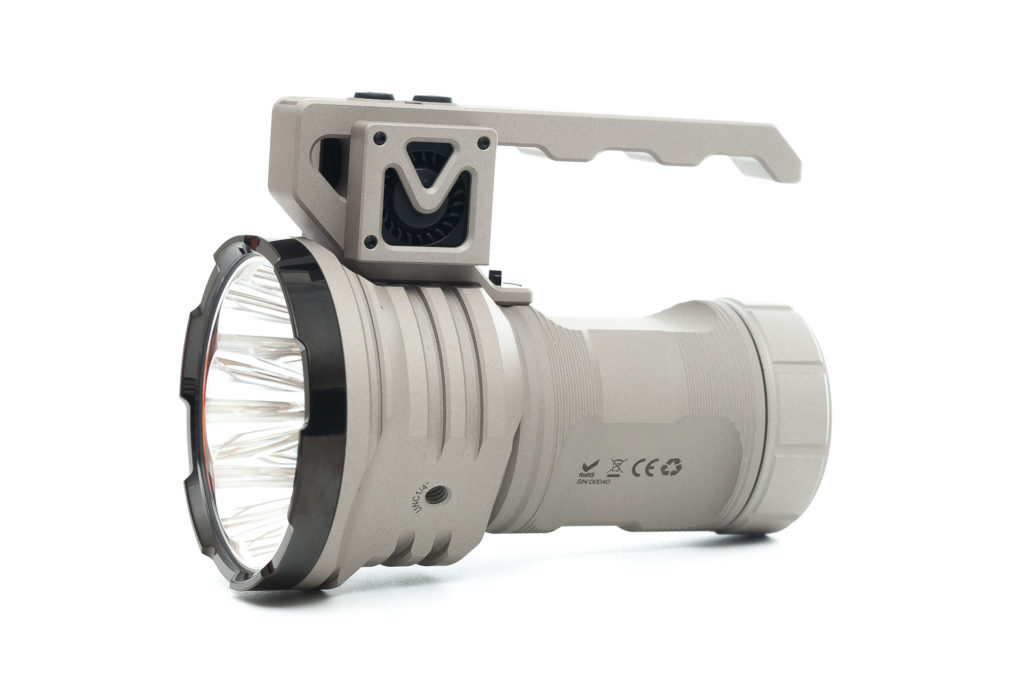
Manker MK38 specifications
| Brand/model | Manker MK38 |
|---|---|
| Category | High power flashlight |
| LED | 8*Luminus SFT40* |
| Max. Lumens | 20,000 lm* |
| Max. Beam intensity | 360,000 cd* |
| Battery config. | 3*21700* |
| Onboard charging | N/A |
| Modes | 6+4 eco modes |
| Blinkies | Strobe / Beacon / SOS |
| Reflector | Smooth |
| Waterproof | IPX7 |
| Review date | February 2022 |
Introduction:
We haven’t reviewed many Manker flashlights, but there was quite a bit of talk in the community about the MK38, so we wanted to test it. It’s available with 3 different kind of LEDs, XHP70.2 CW, XHP70.2 NW, and Luminus SFT40. This review is using the Luminus SFT40, which has a combination of throw and power. Its specifications mention a reach of 1,200 meters and a max output of 20,000 lumens. That’s a bold claim. Then there’s a choice between a built-in battery pack and one without, besides 3 different colors of anodization. Enough choice.
Let’s hurry and get to the juicy part of the review.
Package quality.
Manker sends the MK38 in a hard carton box with its popular orange and black brand colors. On the side of the box, they tell you what version you receive, with the color of anodization, built-in battery pack, and the choice of LEDs. Inside the box you can find the following:
- The flashlight: Manker MK38
- Handle with built in fan (attached to the light)
- Lanyard
- Extra o-ring for covering the port of the handle
- Warranty card / manual
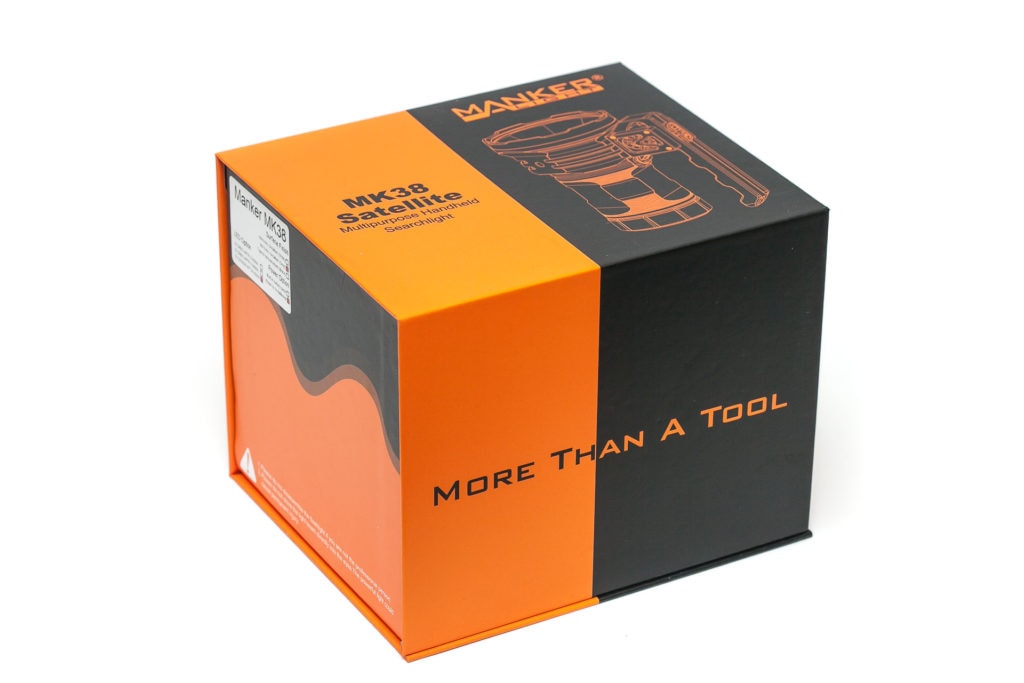
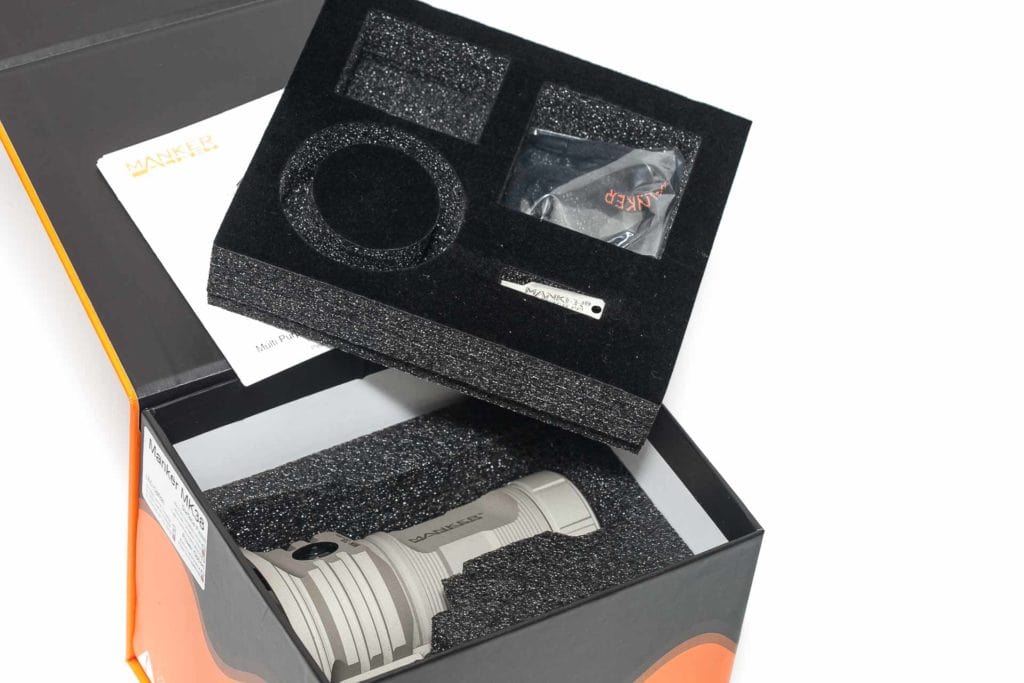
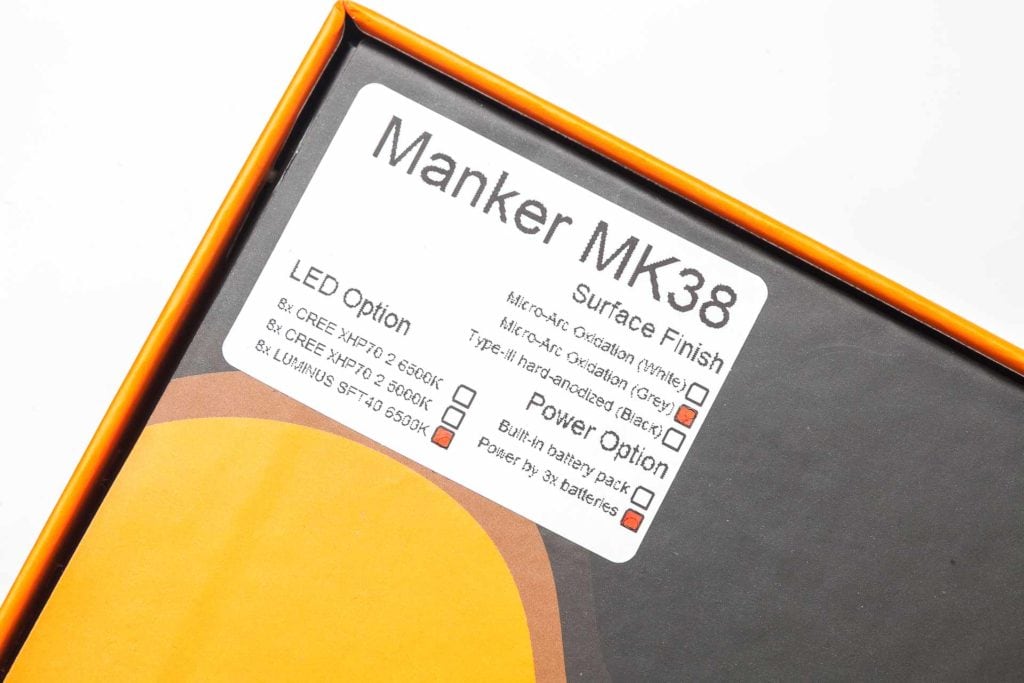
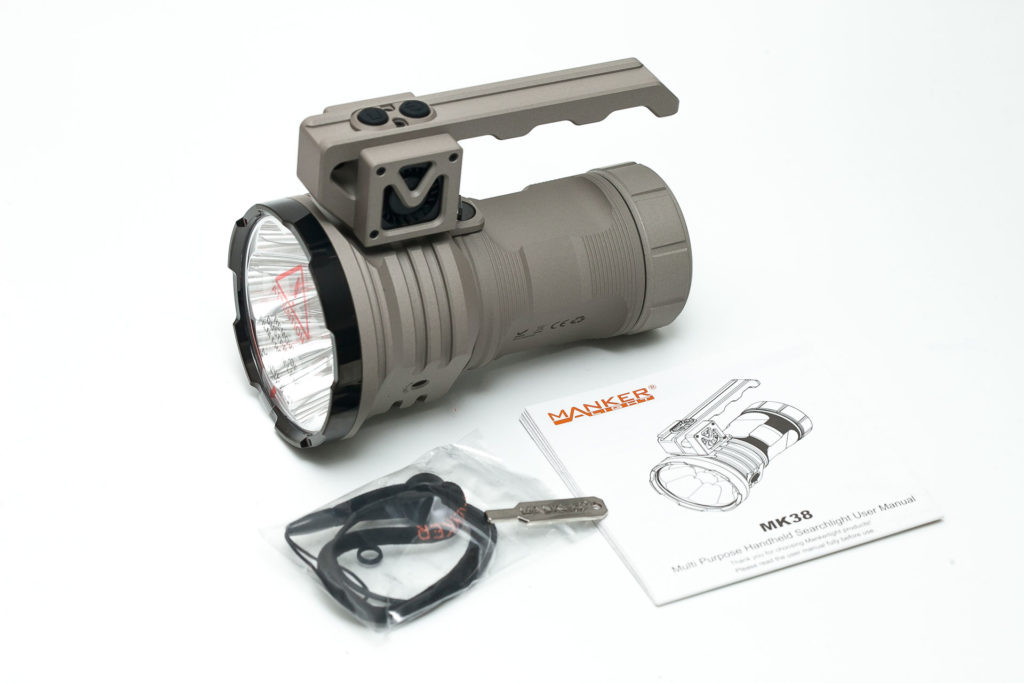
Flashlight in use
Manker gives you a couple of options to carry and use the MK38.
- With the handle attached
- With the handle attached and the lanyard
- With the handle removed
- Attached to a tripod, with or without the handle
Please note: When you remove the handle, you need to cover the electronics with the same screw the handle is attached with. In order to remove the handle, you have to use the tag tool they include. It looks like a flat head screwdriver.
On top of the handle are 2 switches. 1 is for power and mode switching, and the other is for controlling the fan. The fan can be turned on without the light being turned on. But when you turn off the light when the fans were used, the fans will also automatically turn off.
I think I would prefer the fans to be independent at all times. So when the flashlight is just crazy hot, the fans can cool the light down even after it is turned off. What do you think?
There is no battery built into the handle, it draws energy directly from the batteries in the flashlight. This is not a bad idea, because the fan can stay on at all times when the flashlight is running. Other brands use a battery to power the fans, and it might get empty before the flashlight runs out of juice.
Both have their pros and cons.
Even without traditional knurling, the light doesn’t feel slippery or anything.
And yes, you can make it tail stand pretty stable.
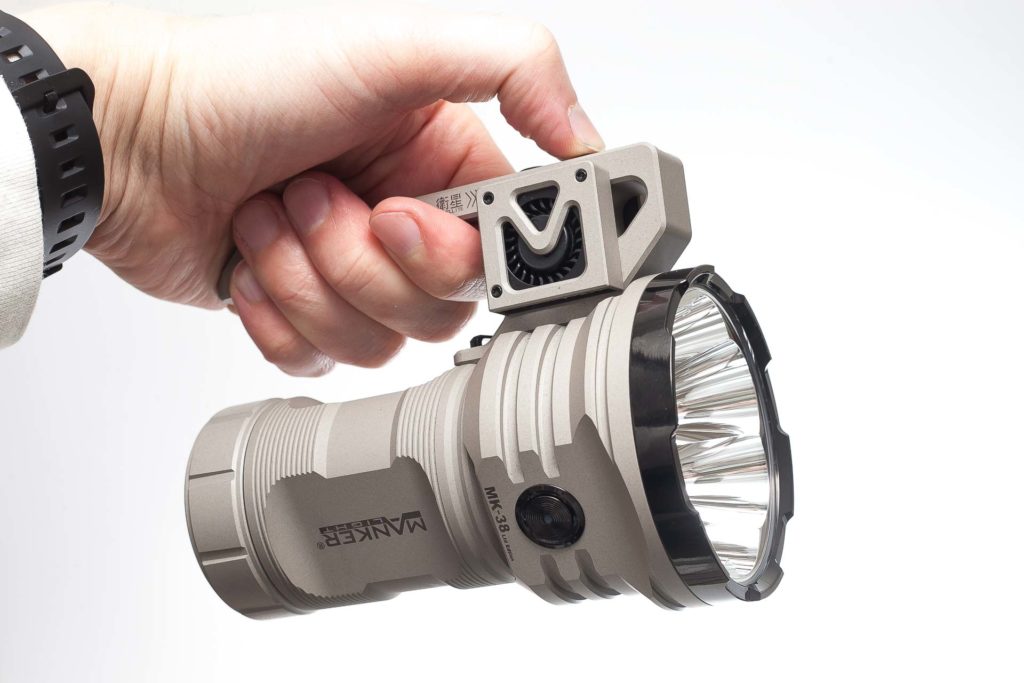
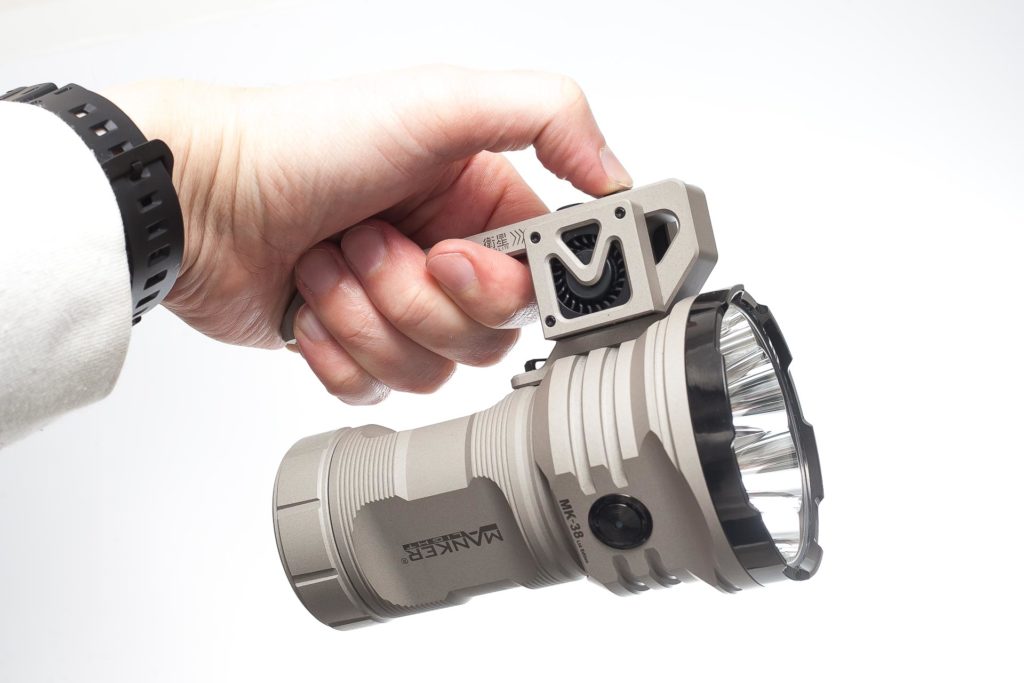
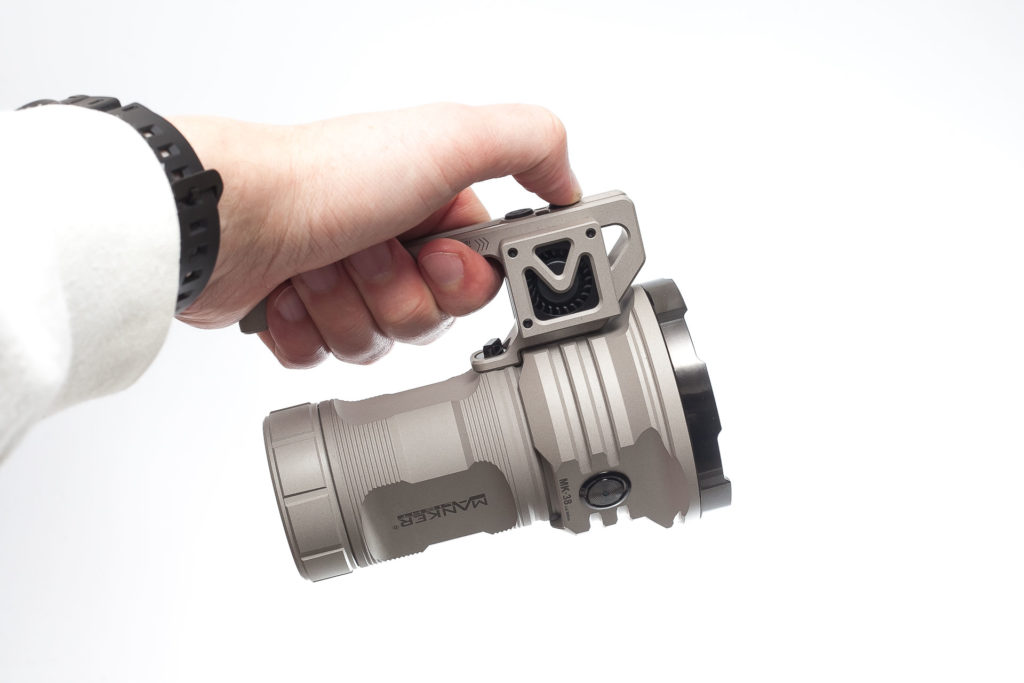
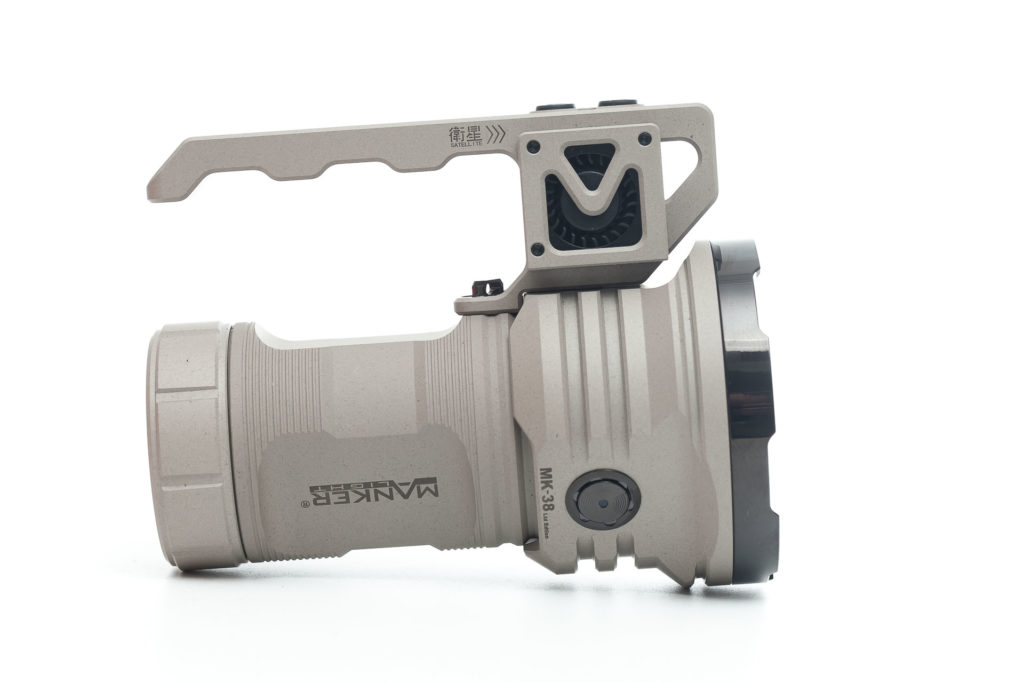
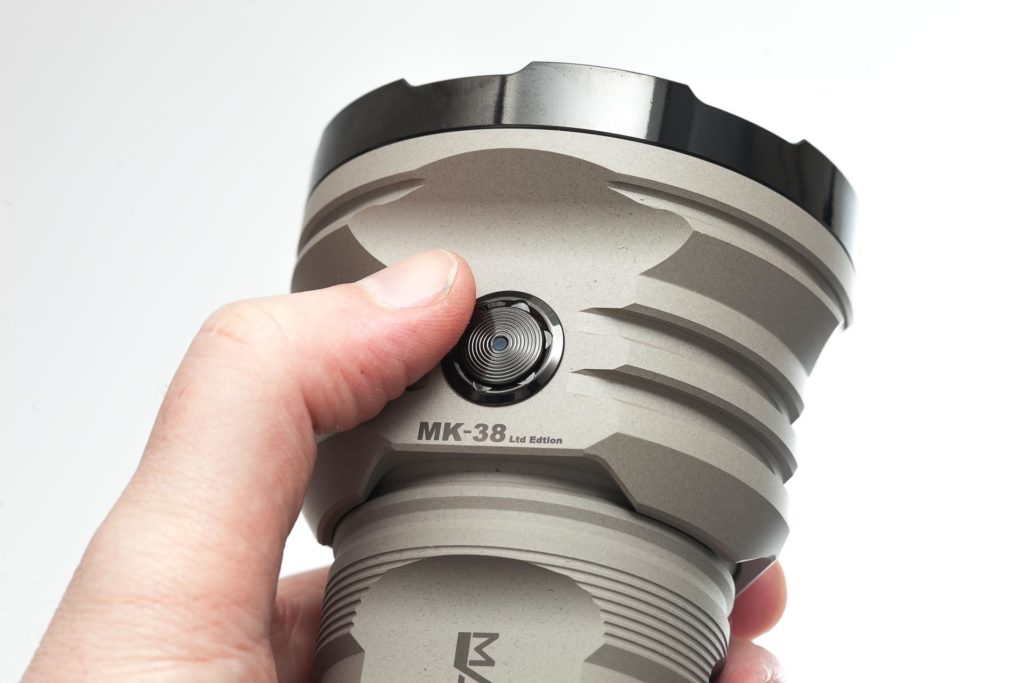
Build Quality, and Warranty
Manker may not be the easiest company to communicate with, but their products are usually built pretty well. I’ve had an issue in the past with another Manker, but that was likely just an incident. The Manker MK38 looks and feels like it is built like a tank.
Threads are very thick but smooth. The anodization on mine looks really interesting for a flashlight. It’s not a monotone color, but it has specks of different colors and looks really good. Have a look at the following pictures to understand what I am talking about. Manker let’s you choose between Black (Type III hard-anodized Oxidation), White (Micro-arc Oxidation), and Grey (Micro-arc Oxidation). And the one in this review is the Grey one.
The bezel looks really interesting, and although it says: stainless steel in the description, it doesn’t look like it. It looks almost like an exotic kind of metal.
Even the handle feels really good, and I must say, it feels better than the one provided with the Acebeam X80-GT2. It’s wider, thicker, and of course has the 2 fans built in.
Warranty Details (taken from the website)
Mankerlight provides easy, reliable, speedy service to all lights under our warranty. Dealers will be responsible for customers.
1. Please contact the dealer for replacement if you experience any problem with Manker product within 15 days.
2. The dealer will offer a free repair service or replace the flashlight with the same or similar model if Mankerlight flashlight fails during normal use within a period of 5 years.
3. LEP flashlight, rechargeable battery, flashlight with built-in battery are warranted for a period of one year (12 months) from date of purchase.
Source: http://www.mankerlight.com/shipping-warranty/
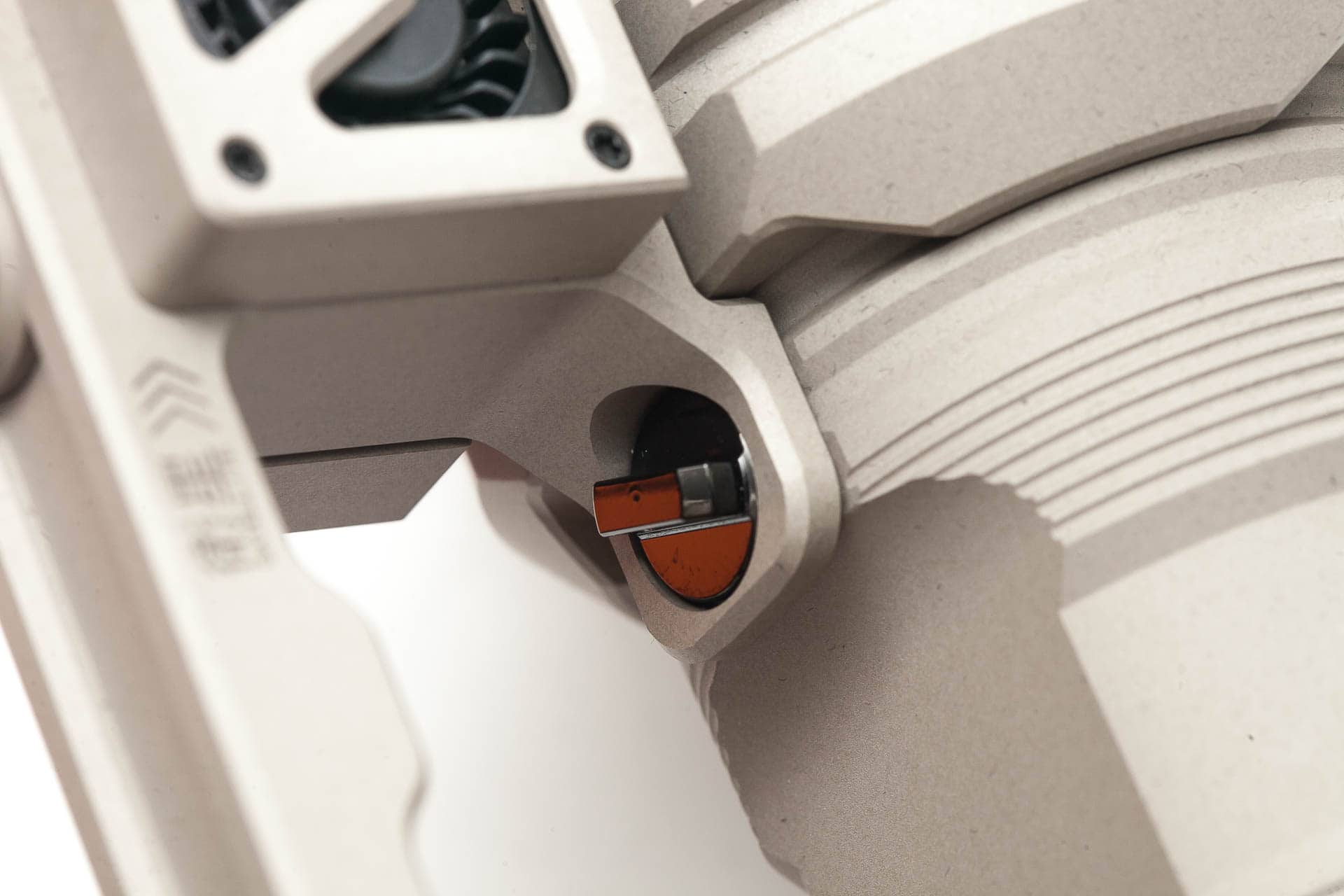
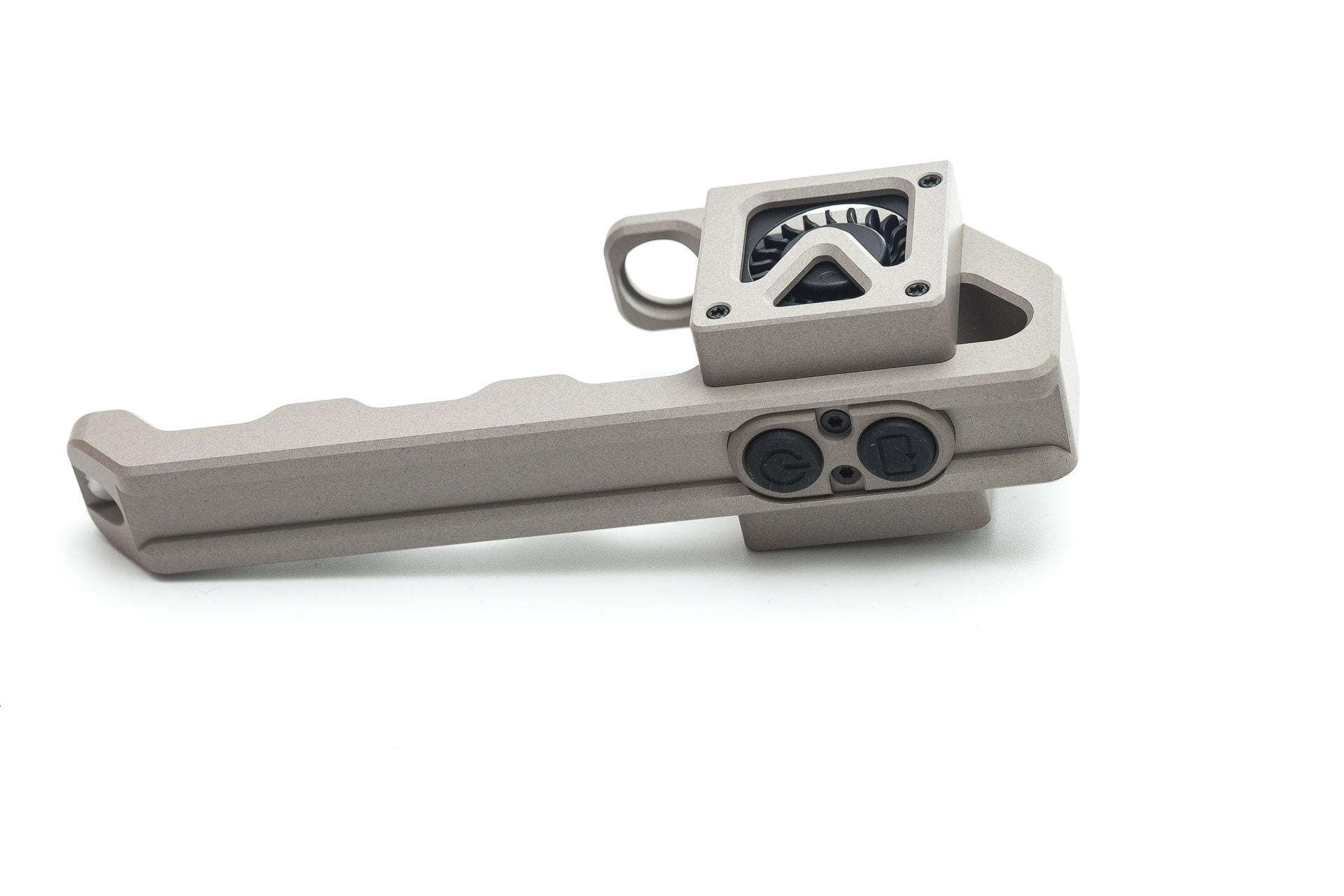
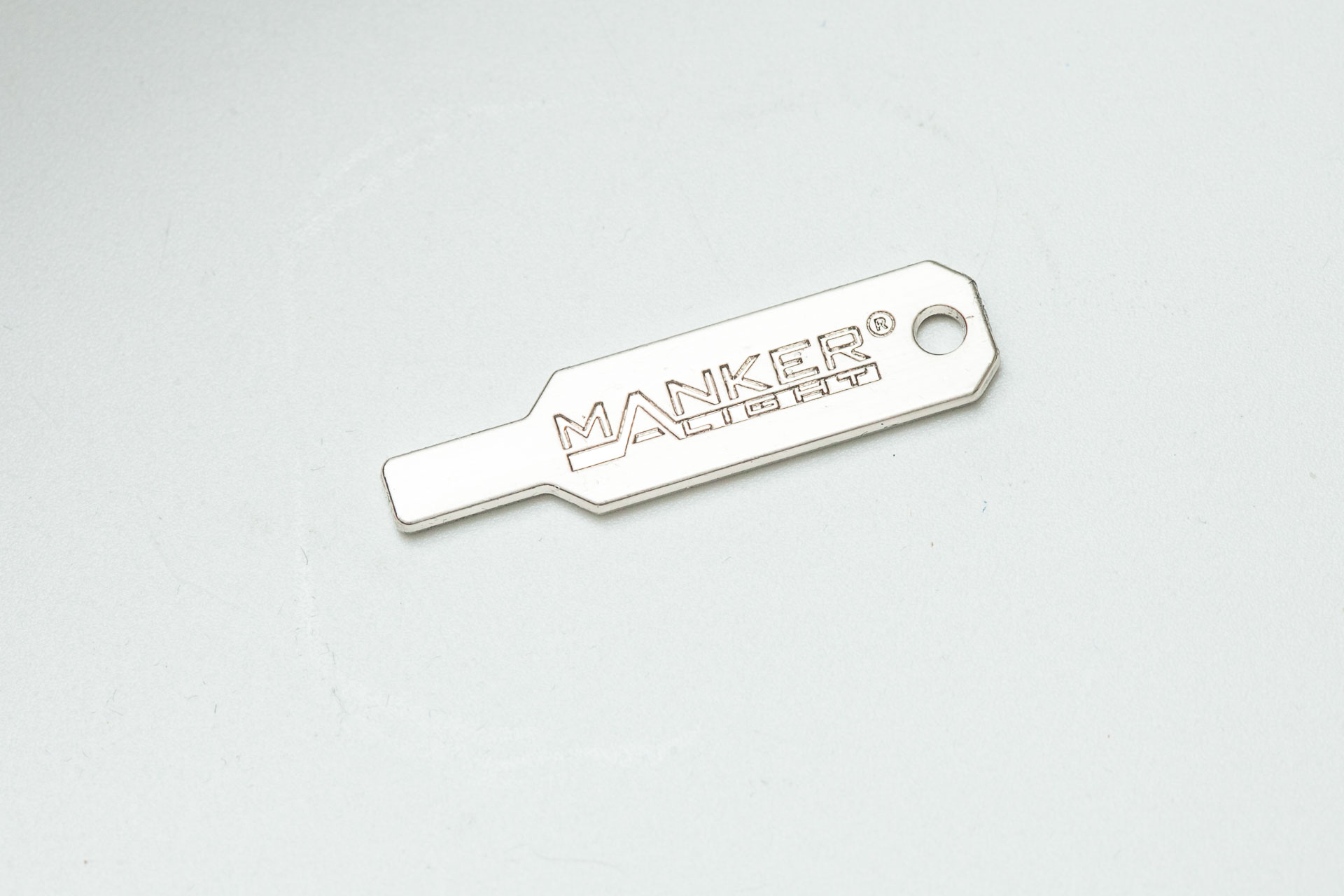

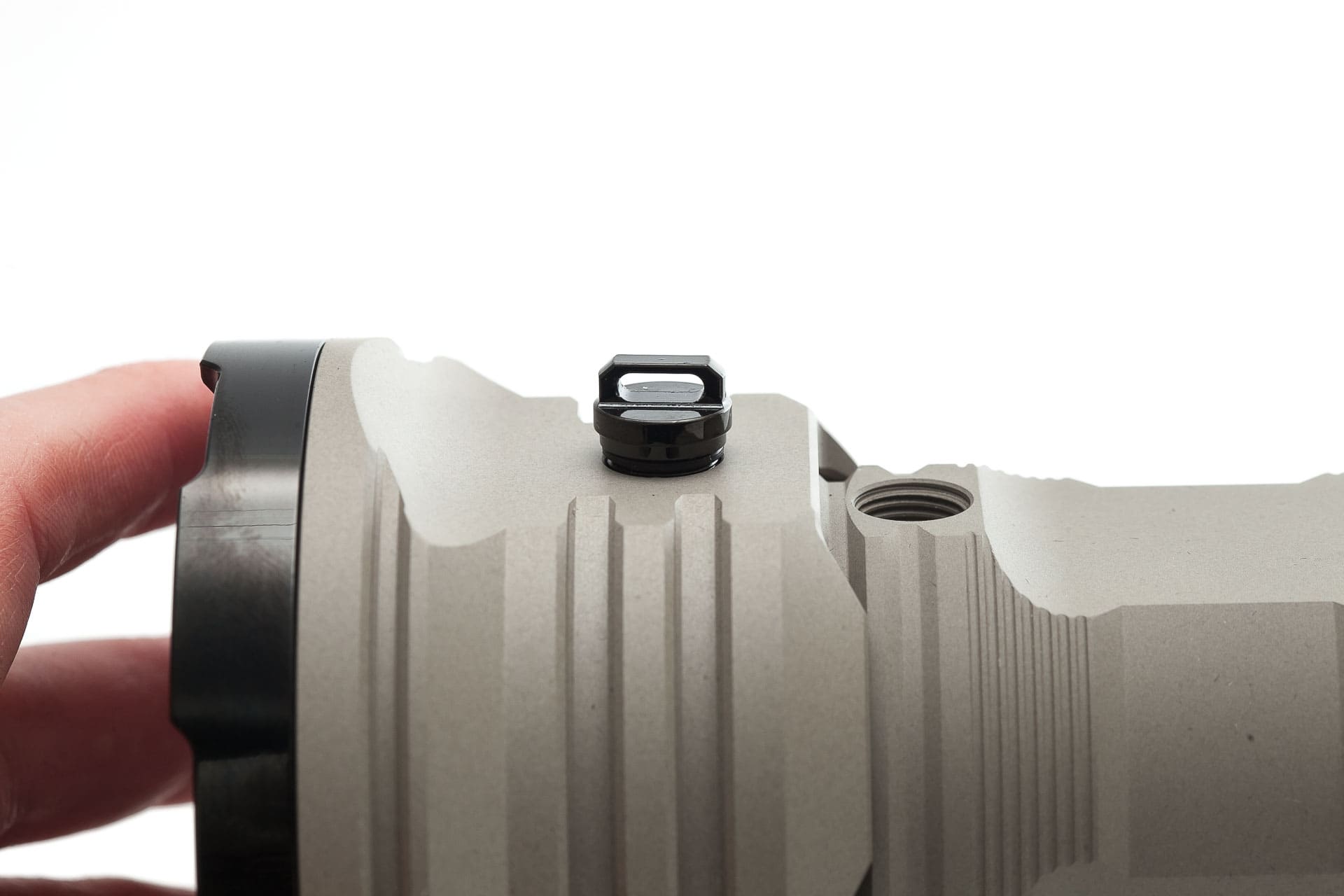
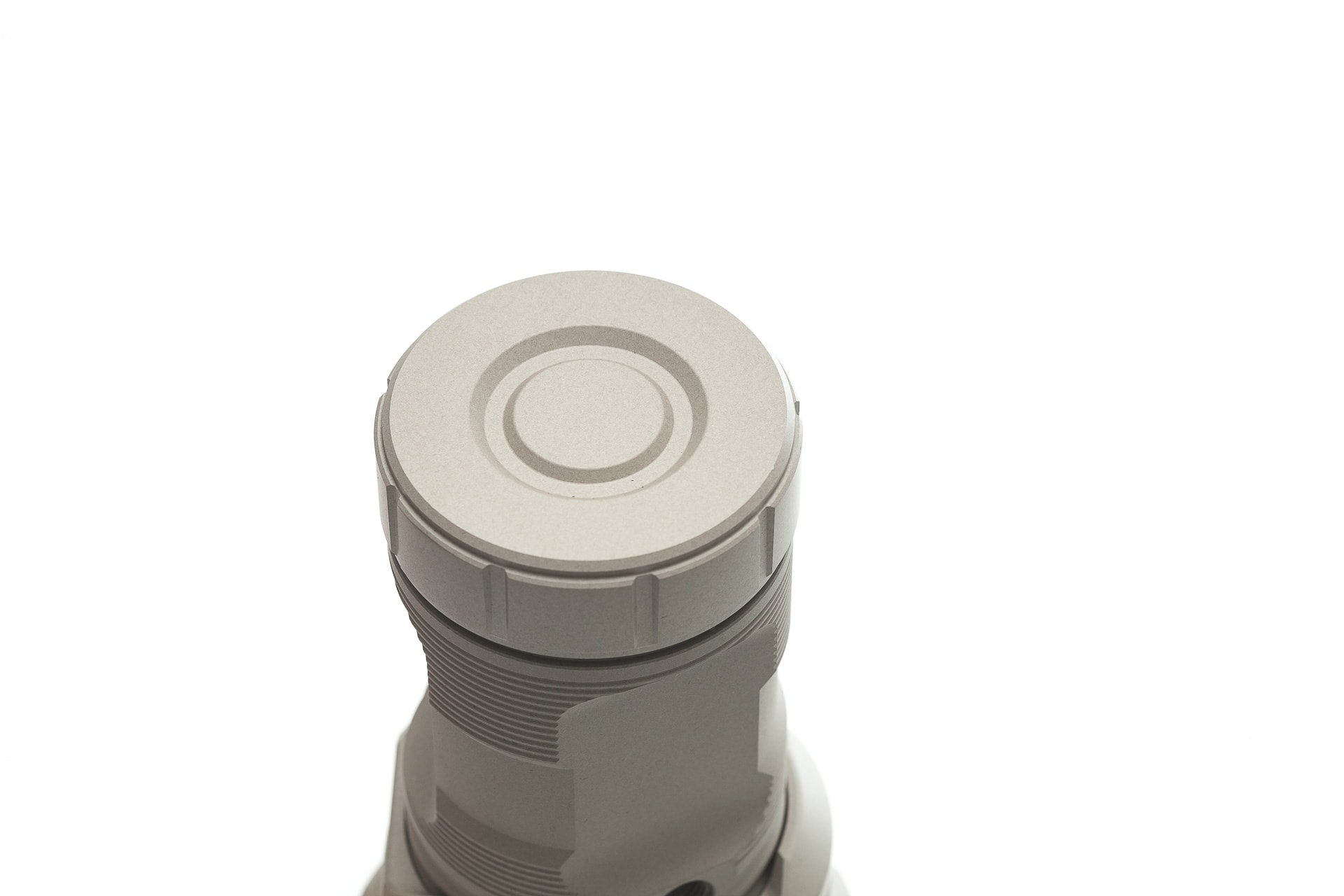
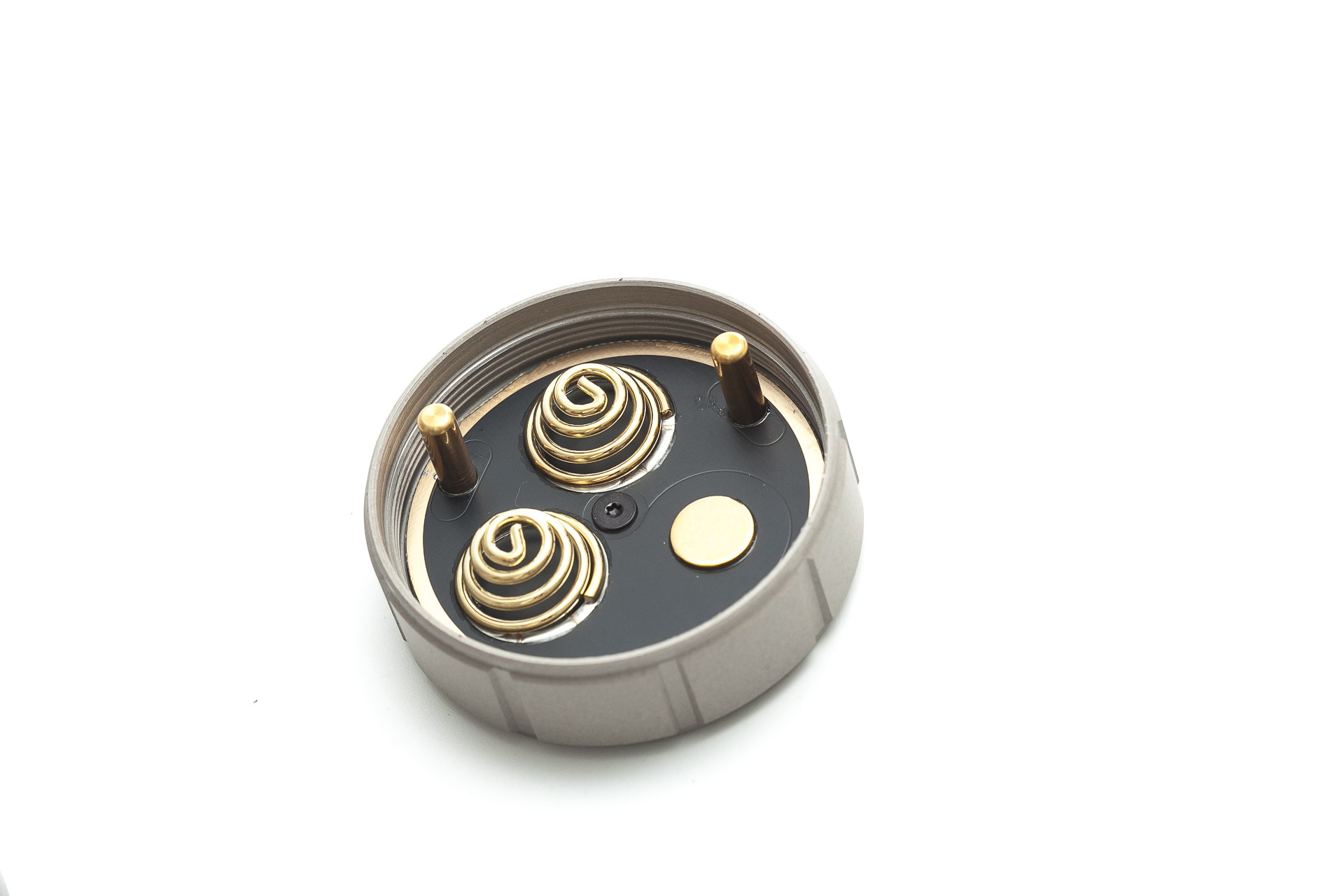
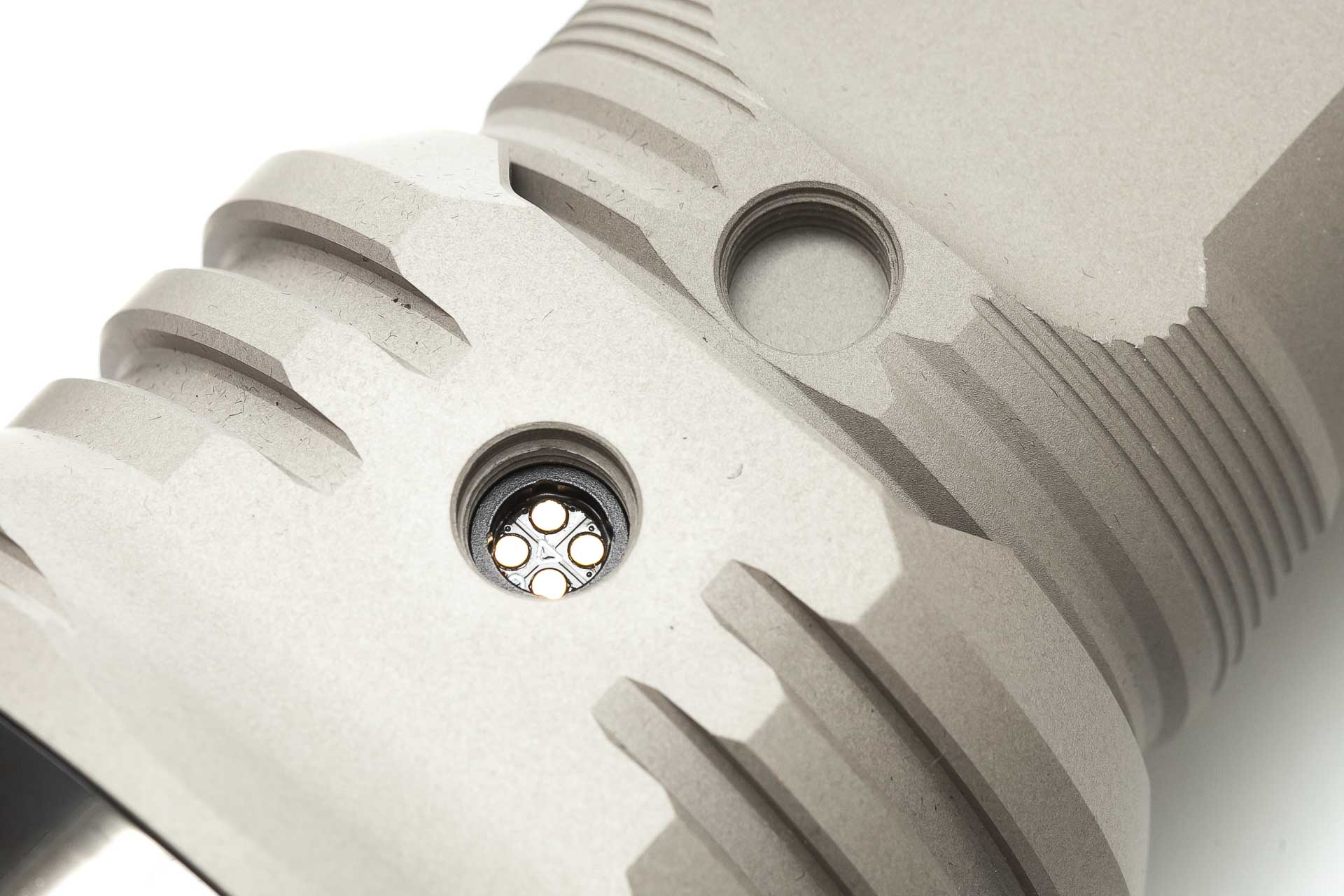


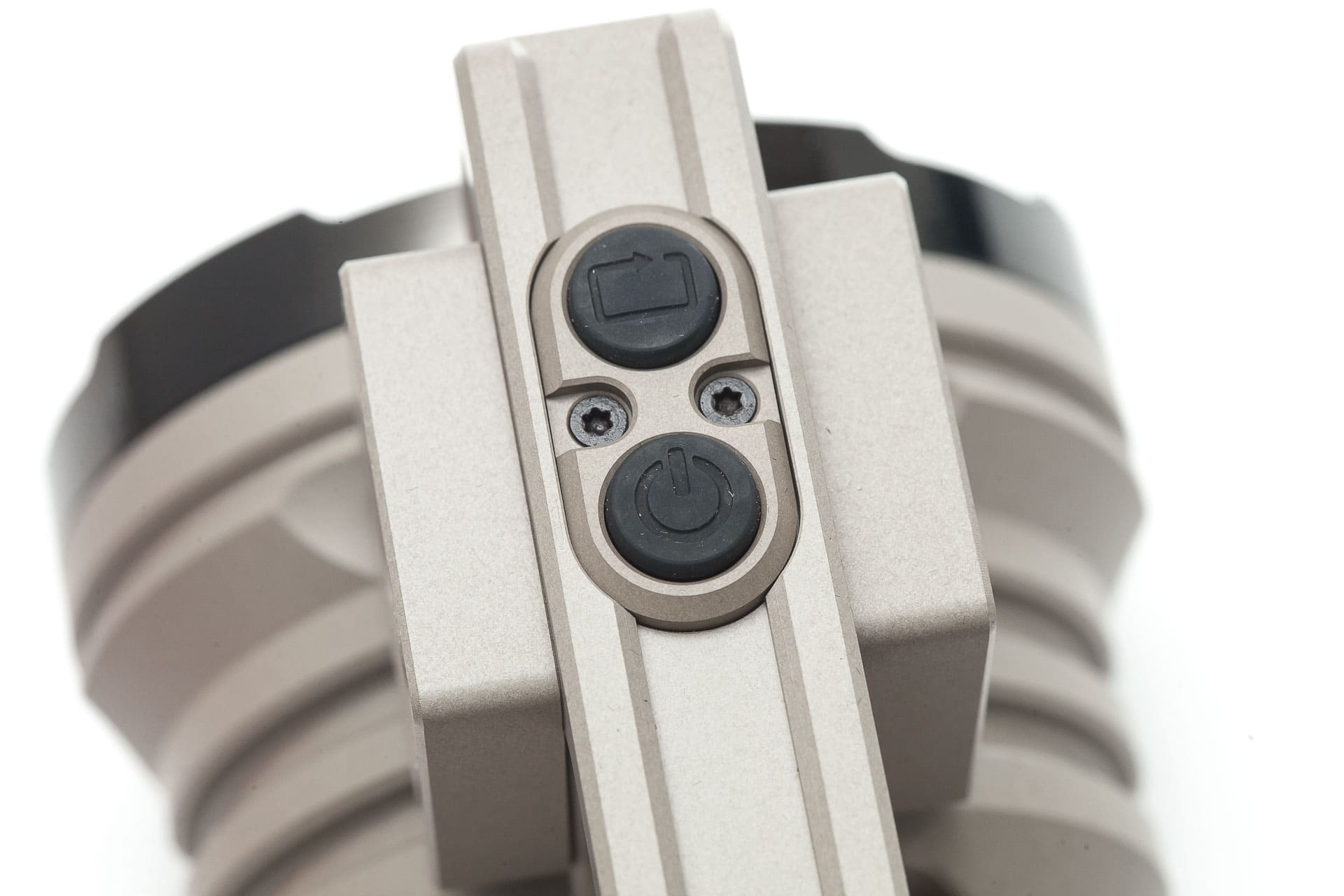

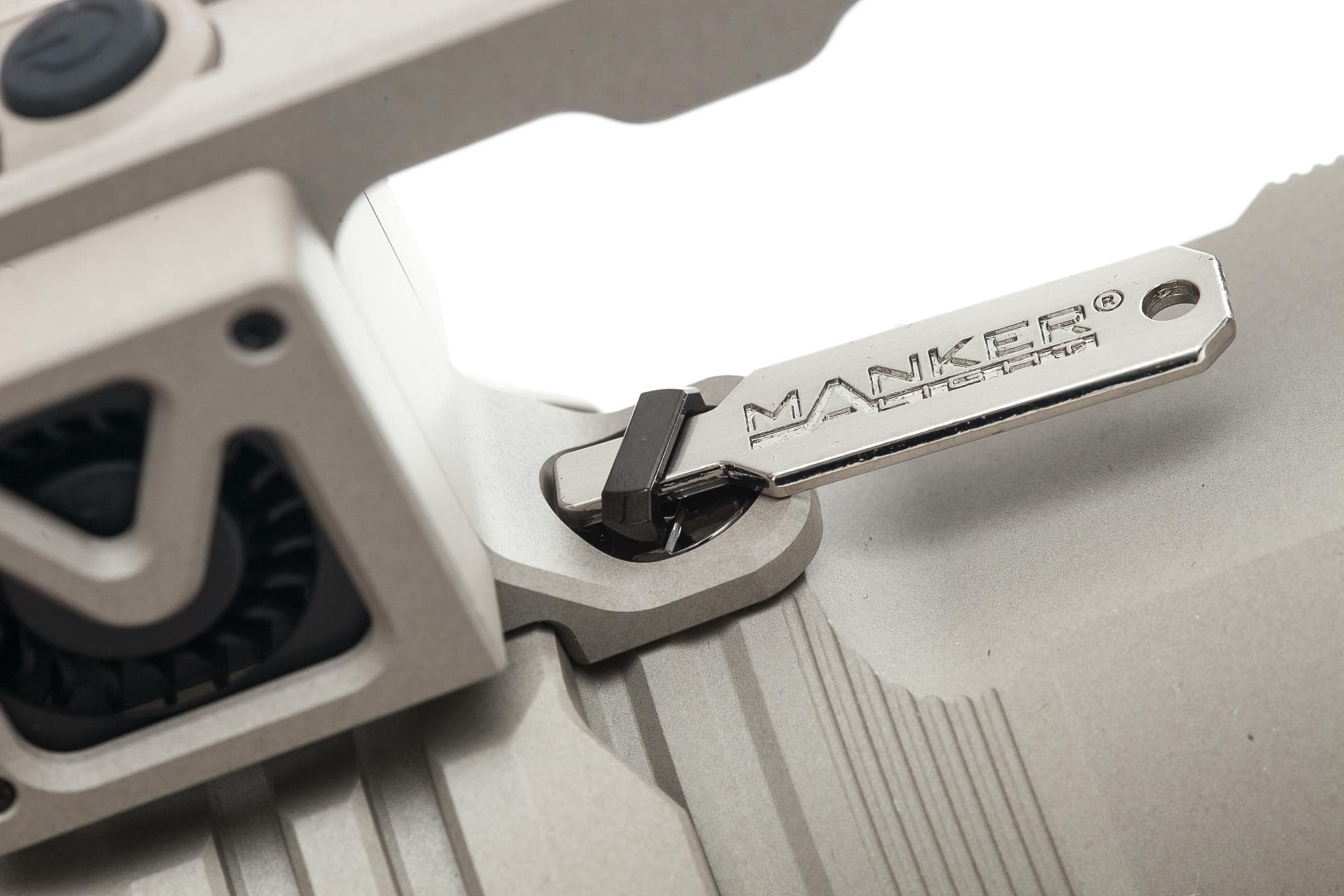
LED, Lens, Bezel, Beam, and Reflector
Now it is starting to get more interesting. Manker gives you 3 LED options. 8*CREE XHP70.2 CW (cool white 6500K), 8*CREE XHP70.2 NW (neutral white 5000K), and 8*Luminus SFT40 (6500K).
The one in this review is sporting the 8*Luminus SFT40’s. They aren’t as powerful as the XHP70 options but have at more than double the throw. So a great competition for the Acebeam X80GT with XHP50.3, and the Imalent RS50 in terms of output and throw.
They sit in smooth reflectors about 1-1.5 inches deep.
The bezel is advertised as Stainless steel, and that could be true, but it almost looks like an exotic metal. It has a beautiful black mirror-like finish.
I used my Opple Light Master to measure CCT and Ra. From my earlier testing, I noticed that DUV is variable, so I don’t think that’s useful to share, at this point in time with so high power flashlights. I tested the numbers in my homemade integrating sphere, in mode Mid 2 or Mid 1, a few seconds after turning on.
- CCT: 5870K
- Ra (CRI): 65.2
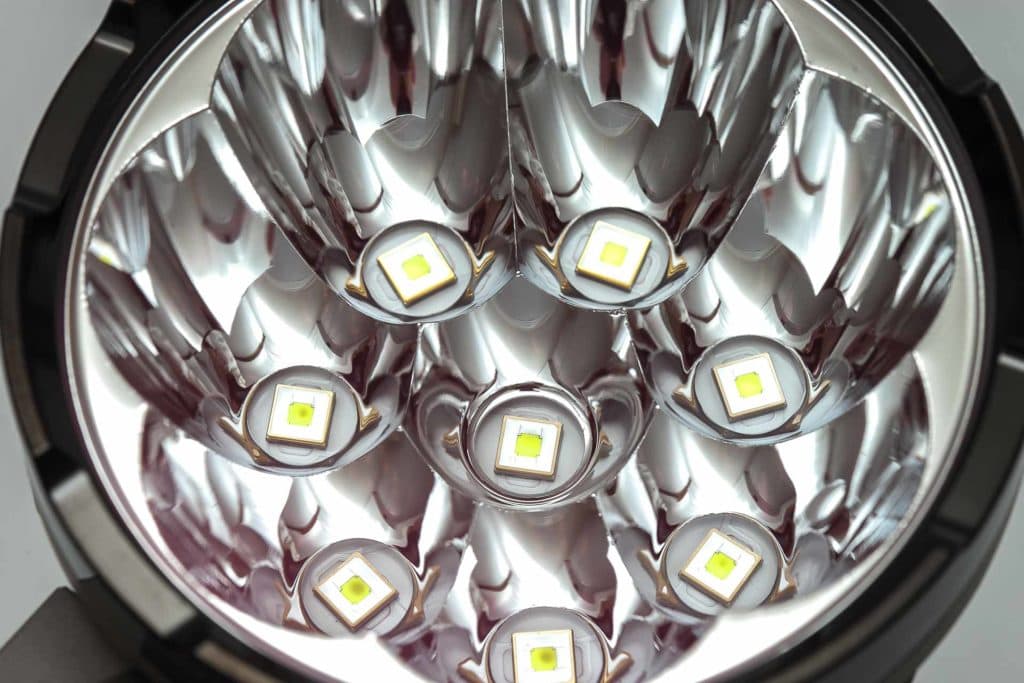
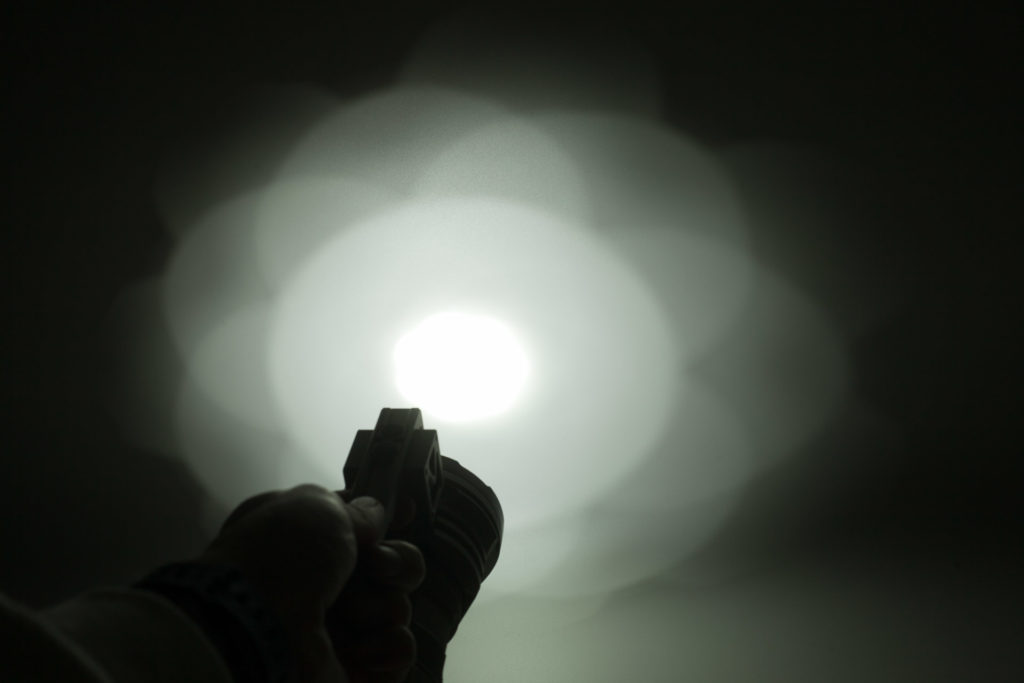
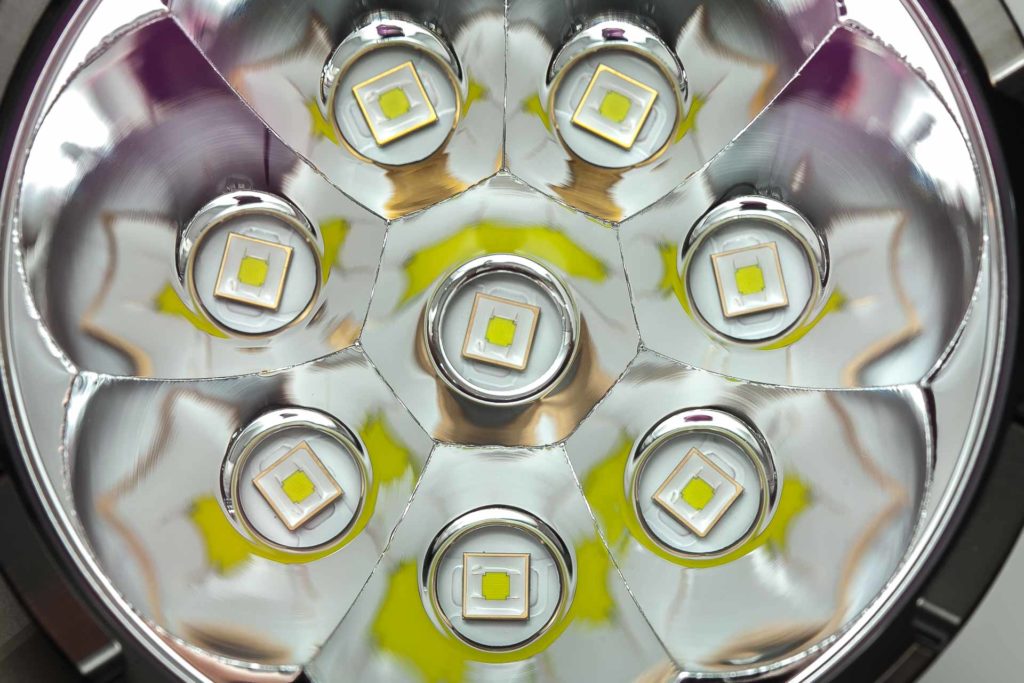
Dimensions and size comparison
- Length: 139 mm / 5.49 ”
- Bezeldiameter: 80 mm / 3.15 ”
- Tailcap diameter: 57.5 mm / 2.26 ”
Weight with handle
- Empty: 702.5 g / 24.78 oz
- With battery: 910 g / 32.1 oz
Without handle:
- Empty: 587.3 g / 20.71 oz
- With battery: 794.7 g / 28 oz
Lumenmonsters comparison
Size compared to some of the brightest flashlights (soda can sized).
Image 1, from left to right: Manker MK38, Olight Marauder 2, Acebeam X50, Imalent MS08, Imalent RS50, Acebeam X80-GT, Imalent X80-GT2, Lumintop GT3.
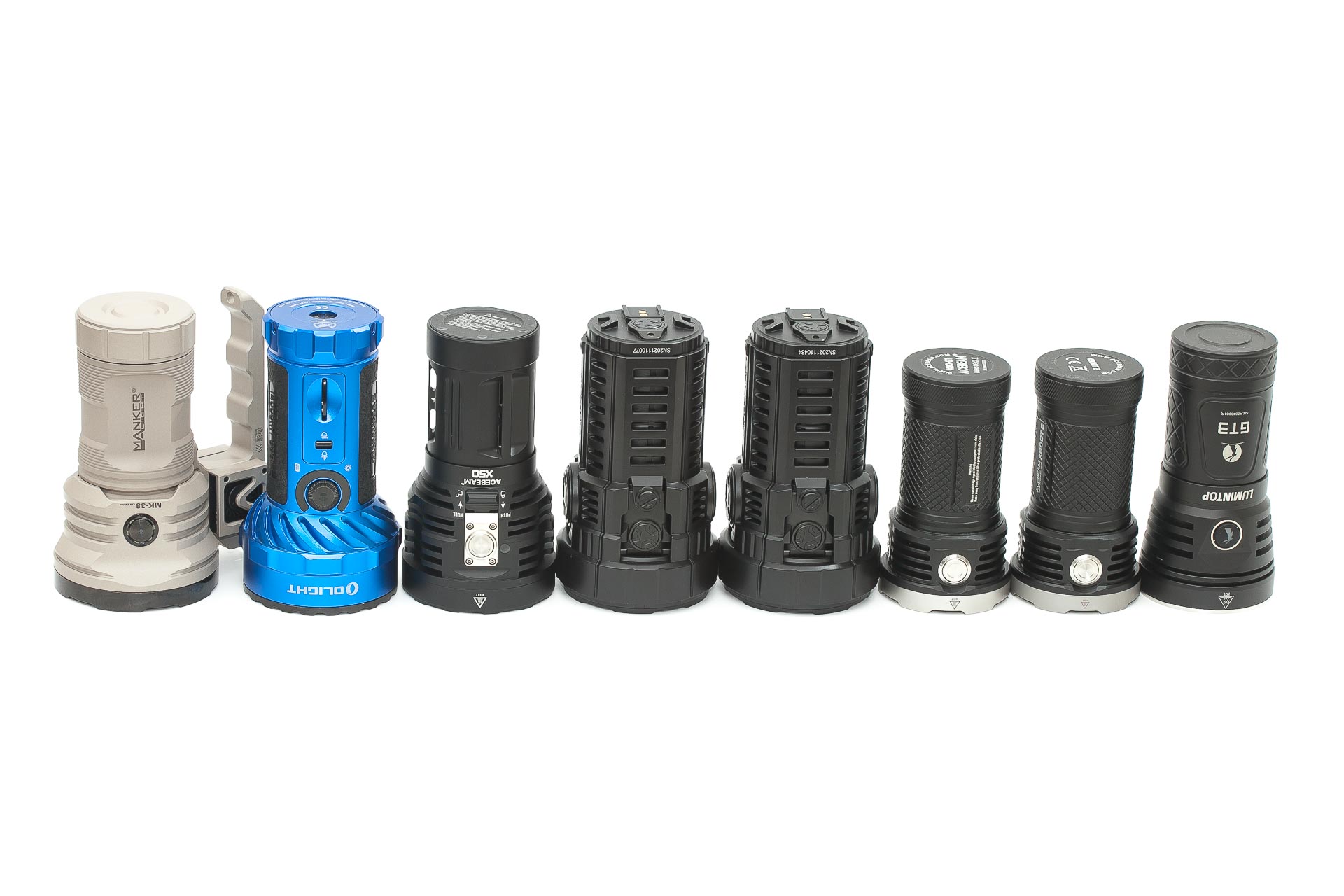
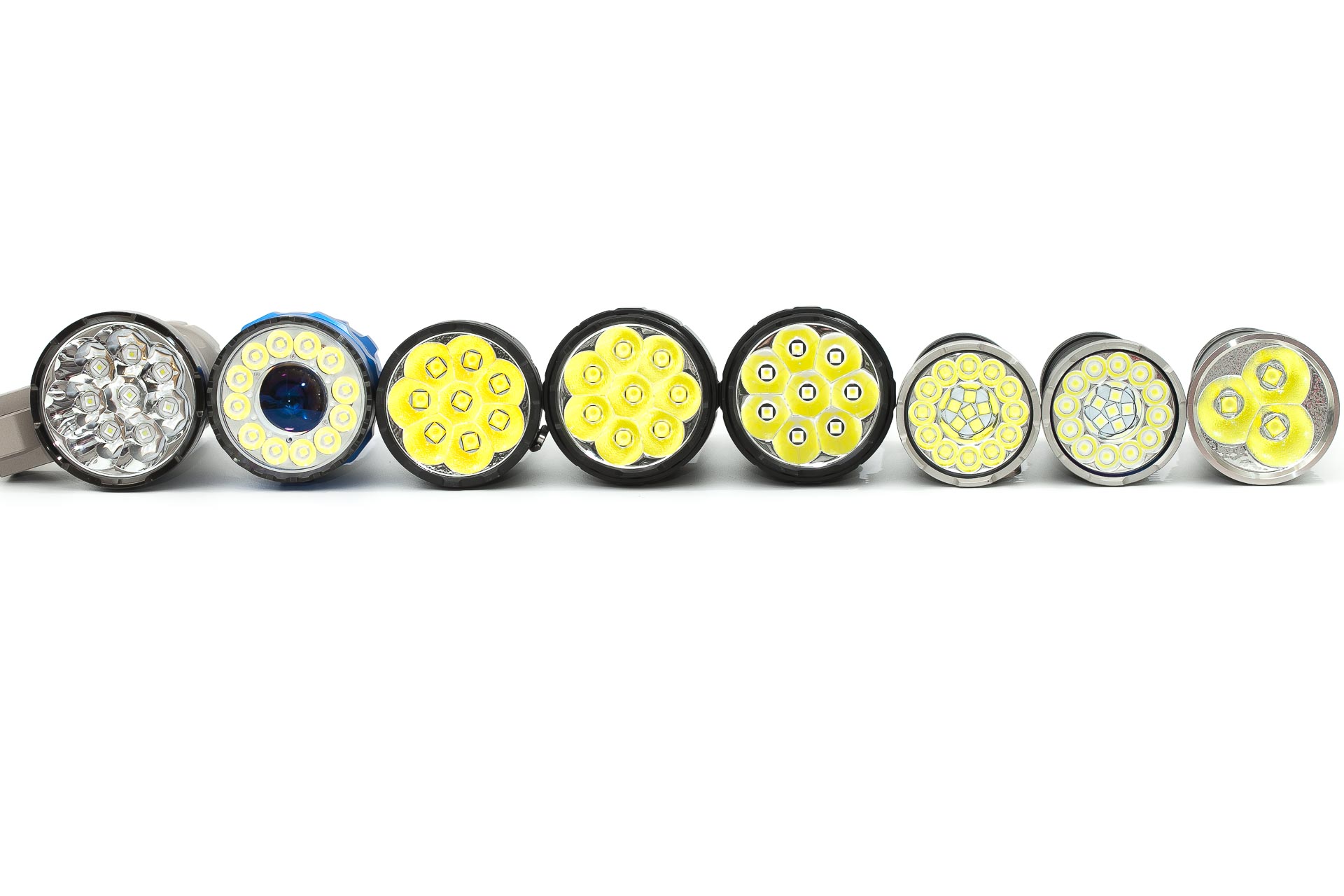
Driver & User Interface:
Manker uses its own User interface, which is rather unique. I like the idea that companies come up with their own UI, although I also like simple UIs that can be found on many flashlights. Anyway, here is the explanation.
The main switch and the one on the handle can be used interchangeably. You can turn the light on with 1, and change modes, or turn off with the other, and vice versa.
Available modes:
- Low, Mid1, Mid2, Mid3, High, Turbo
- Eco1, Eco2, Eco3, Eco4
- Strobe / SOS / Beacon
From OFF:
- Single-click: to last used mode in Main mode menu (Low, mid1, mid2, mid3, high)
- Double click: Turbo
- Triple-click: Strobe (press and hold to cycle through Strobe, Beacon, and SOS) (not memorized)
- Press and hold 1 sec: to last used mode in Eco mode group (Eco1, Eco2, Eco3 or Eco4)
- Press and hold 3 sec: turn on/off side switch light
From ON:
- Single-click: Turn off
- Double click: Turbo
- Triple-click: Strobe mode (not memorized)
- Press and hold: Cycle through the menu from Low to High
Shortcuts:
- To Turbo: double click from on/off
- To Moon: long-press from off
- To Strobe: triple click from on/off
Mode memory:
- Yes, Eco modes and Main modes (blinky modes don’t)
Blinky modes menu:
- Yes. A triple click will activate strobe, and then a long-press for beacon and SOS. they will not be memorized
Low battery warning:
- The light will reduce output, and turn off. The resting voltage is about 3.1V, so that is safe!
Lock-out mode:
- 4 clicks. And with 1 click you will turn on/off the lighted switch
PWM:
- Not visible
Firmware / UI Conclusion:
Quite a standard and great UI. I also like the ability to have 4 ECO modes, in case you prefer low output only.
Batteries & Charging
Manker gives you 2 options: a battery pack, or 3 separate cells. The one I got was just 3 separate cells, so I used some Samsung 30T and 40T for testing.
It doesn’t accept long protected batteries! Stick to unprotected flat tops, and you’ll be fine. The following image shows 3*30T flat tops.
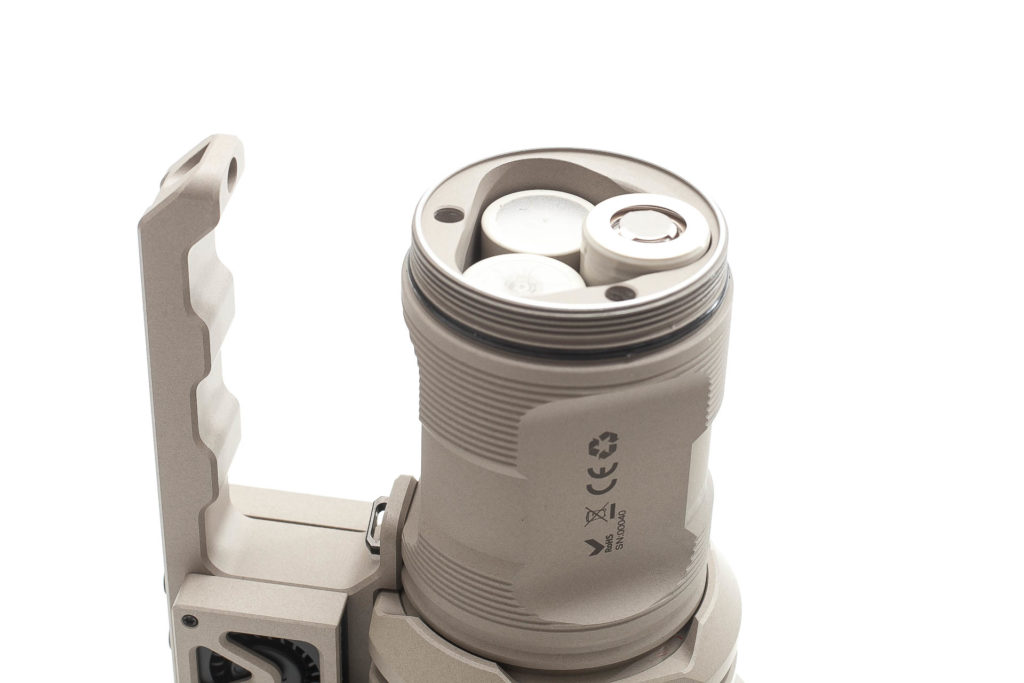
Performance
Lumen measurements:
All output numbers are relative to my homemade Integrating Sphere. It is set up with an Extech SDL400 Lux Meter for measurements including a Kenko PRO1D ND-16 filter. The base measurement is done with a Convoy S2+ that has been tested at 255 lumens.
For Amp readings, I use a Fluke 77III DMM. For higher amps, I now use a Fluke 325 True RMS clamp meter. For microamps, I use a cheap DMM with an easy-to-use micro amp setting.
All of my readings were taken from fully-charged Samsung INR21700 30T and INR21700 40T batteries.
First table with 30T measurements. I measured manually at the start and 30 seconds. The runtime graphs are done with the 40T batteries. The light drops very quickly, so around the 30-second measurement, the light changes numbers quickly, so I wrote down what I saw ‘around’ the 30-second mark.
| Mode | Specs | start | 30 sec |
|---|---|---|---|
| Low | 650 | 711 lm | 711 lm |
| Mid1 | 1,300 | 1,215 lm | 1,213 lm |
| Mid2 | 2,500 | 2,248 lm | 2,241 lm |
| Mid3 | 5,000 | 4,232 lm | 4,180 lm |
| High | 10,000 | 8,510 lm | 8,080 lm |
| Turbo | 20,000 lm | 16,522 lm | 13,429 lm |
Just for fun, here are the turn on measurements for the Eco modes with 30T’s
| Mode | Specs | at start |
|---|---|---|
| Eco1 | 40 lm | 41 lm |
| Eco2 | 80 lm | 82 lm |
| Eco3 | 160 lm | 161 lm |
| Eco4 | 320 lm | 314 lm |
Here are the measurements with Samsung INR21700 40T’s.
The 10 minutes measurements were taken from the runtime test.
| Mode | Specs | start | 30 sec | 10 minutes |
|---|---|---|---|---|
| Low | 650 lm | 721 lm | 723 lm | 711 lm |
| Mid1 | 1,300 lm | 1,234 lm | 1,235 lm | 1,206 lm |
| Mid2 | 2,500 lm | 2,246 lm | 2,231 lm | 2,165 lm |
| Mid3 | 5,000 lm | 4,227 lm | 4,167 lm | 3,903 lm |
| High | 10,000 lm | 8,530 lm | 8,098 lm | 6,814 lm |
| Turbo | 20,000 lm | 16,013 lm | 13,129 lm | 2,591 lm |
Runtime:
The runtime test was done with the 50cm integrating sphere, including the Kenko Pro1D ND-16 filter and Extech SDL400 data logging Lux Meter.
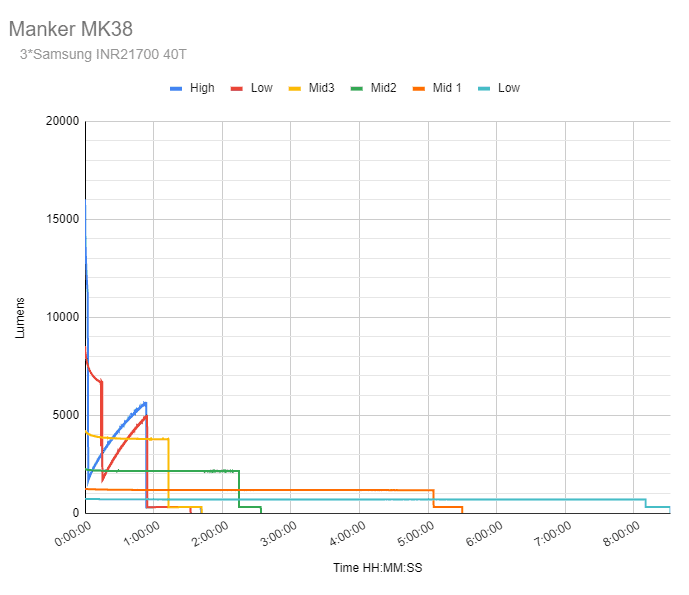
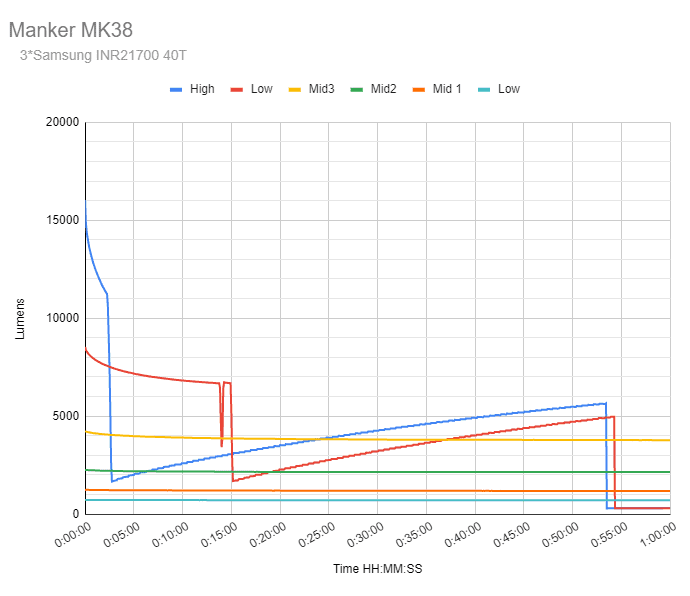
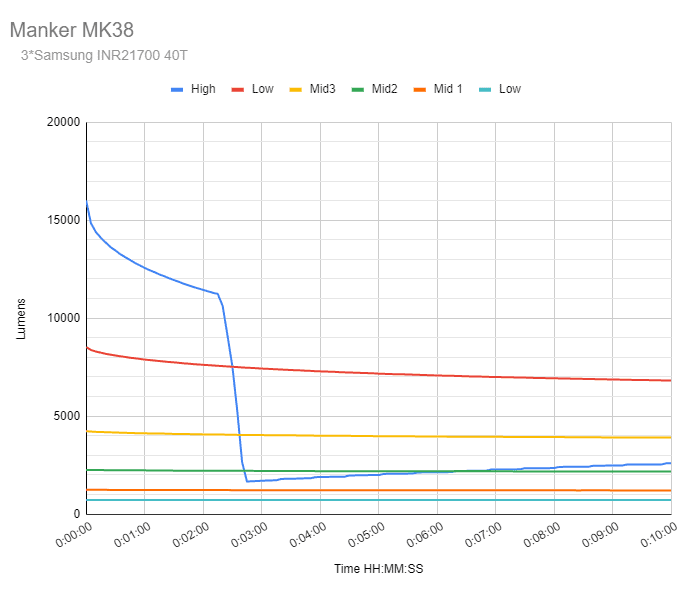
Turbo, High and Medium 3 used fans!!!
Turbo starts at around 16,000 lumens and drops to about 1700 lumens in exactly 3 minutes. It then starts ramping up till it reaches 5650 lumens at 53 minutes. At that point it drops down to 290 lumens until it shuts off at 1h41min. Total runtime is till 10% of the initial output, so that means: 53 minutes
High has similar behavior. But the output starts at around 8500 lumens and slowly drops to 6680 lumens in 15 minutes when it drops to 1700 lumens. (Ther is some string behavior in the line as you can see at roughly 14 minutes.
It has a similar increase after the biggest drop and increases its brightness till it reaches 4960 lumens at the 54-minute mark. It then drops to roughly 700 lumens. At 1h32min it turns off.
Mid 3 is relatively stable and starts almost at 4,000 lumens. Just before 1h13min it drops from 3770 lumens down to about 300 lumens. At 1h42min it turns off.
Mid2 starts around 2246 lumens. At 2h14min it drops from 2140 lumens down to 300 lumens. At 2h33min it shuts off completely.
Mid1 start at around 1234 lumens and runs straight for 5h04min when it drops from 1167 lumens down to 308 lumens. The light shuts off at 5h30min.
Low starts off around 720 lumens and runs for 8h10min when it drops to roughly 310 lumens. It shuts down just short of 8h32min.
Throw Measurement
Measurements were taken both indoors and outdoors with a professional Hagner E4-X Lux Meter. The measurements below were taken at 5 meters. The outdoor measurements at 20 meters were pretty close but harder to measure.
| Specs | Candela measured | in meters | in yards | in miles |
|---|---|---|---|---|
| 360,000 cd | 365,000 cd | 1208 m | 1321 | 0.75 |
My measurements were pretty close.
Manker MK38 vs Acebeam X50 vs Imalent MS08 vs Imalent RS50
High power flashlight comparison
Here is the list with most of the high-power flashlights we reviewed in this category (Category: high-power soupcan sized flashlights).
| Flashlight | Max. Output | after 30sec |
|---|---|---|
| Acebeam X50 | 35,507 | 30,383 |
| Acebeam X75 | 64,295 | 73,716 |
| Acebeam X80-GT2 | 31,890 | 27,143 |
| Astrolux EC06 | 18,111 | 8,352 |
| Fenix LR50R | 11,698 | 10,849 |
| Imalent MR90 | 52,326 | 32,128 |
| Imalent MS08 | 25,745 | 19,615 |
| Imalent MS12 Mini | 68,773 | 46,750 |
| Imalent MS12 Mini C | 71,967 | 55,873 |
| Imalent RS50 | 20,302 | 16,939 |
| Imalent SR16 | 53,657 | 43,115 |
| Lumintop GT3 | 16,267 | 15,168 |
| Manker MK38 (SFT) | 16,013 | 13,129 |
| Olight Marauder 2 | 14,251 | 13,964 |
| Thrunite TN50 | 18,200 | 17,360 |
(Interactive line graphs below)
Hover your mouse over the lines in the graph to see more details, or select a flashlight in the graph.
Using a mobile phone? Hold your phone horizontally!
Another comparison, focusing on the first 10 minutes after activation
And here’s another comparison, but zoomed in. The first 60 minutes after activation.
Beamshots
For the following beamshots, I used a Canon EOS 5D Mk2 and a 50mm lens. manual settings: ISO1600, 1/4sec , F4, 5000K
The shed is about 65 meters / 71 yards away.
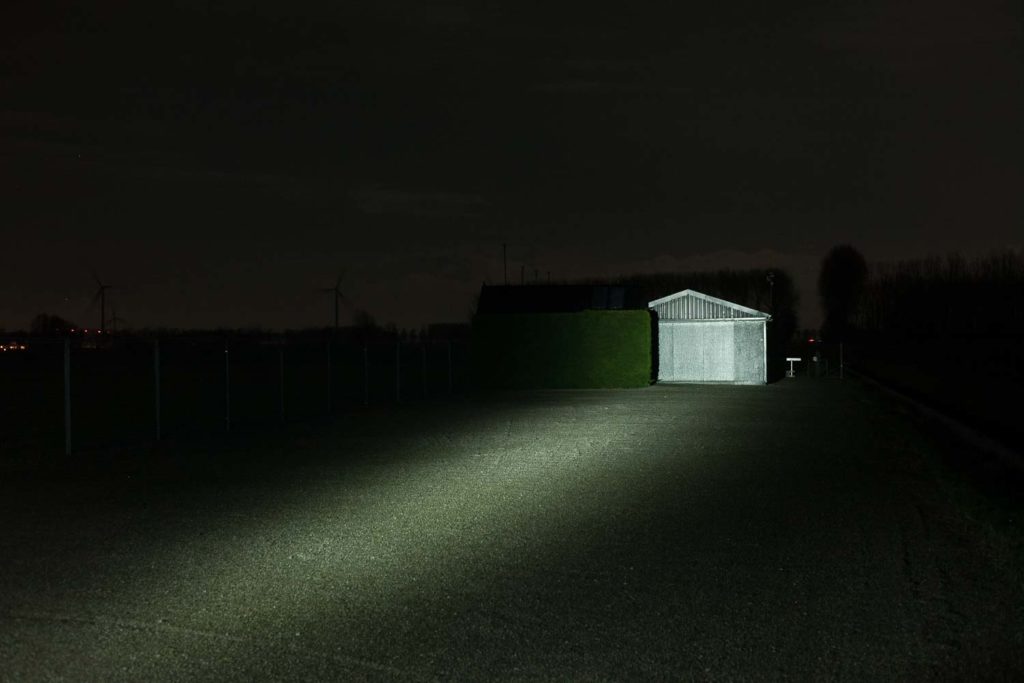
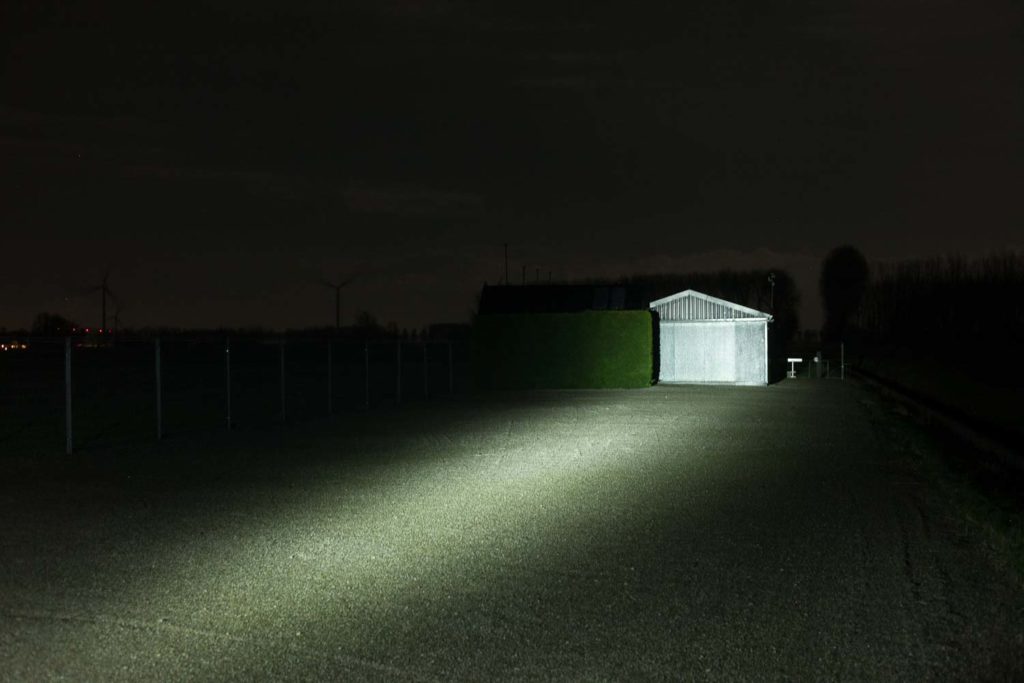
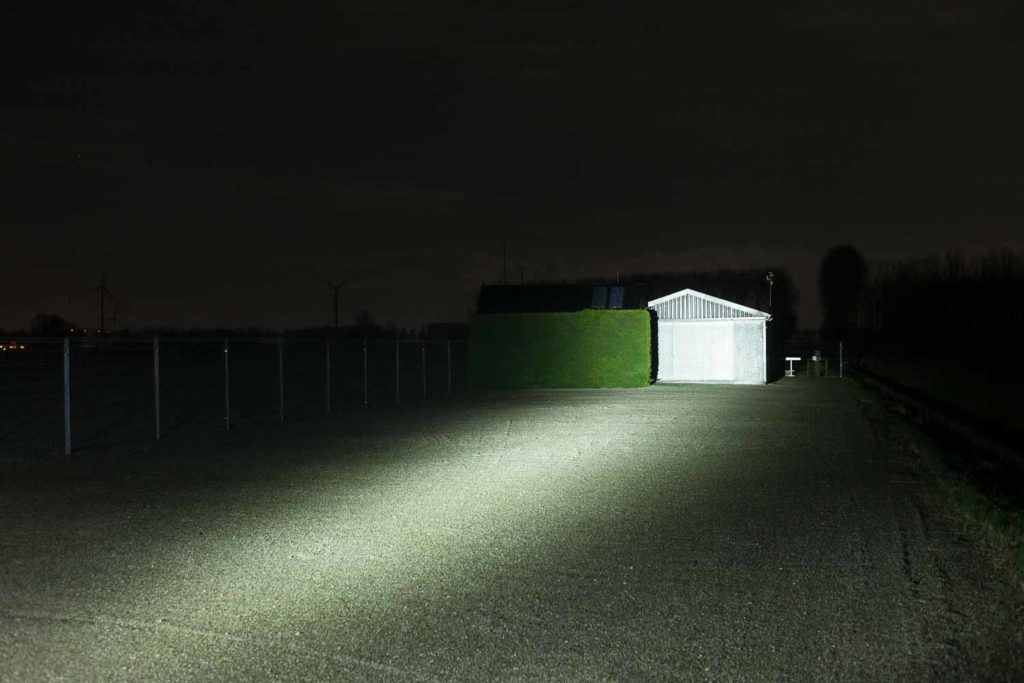
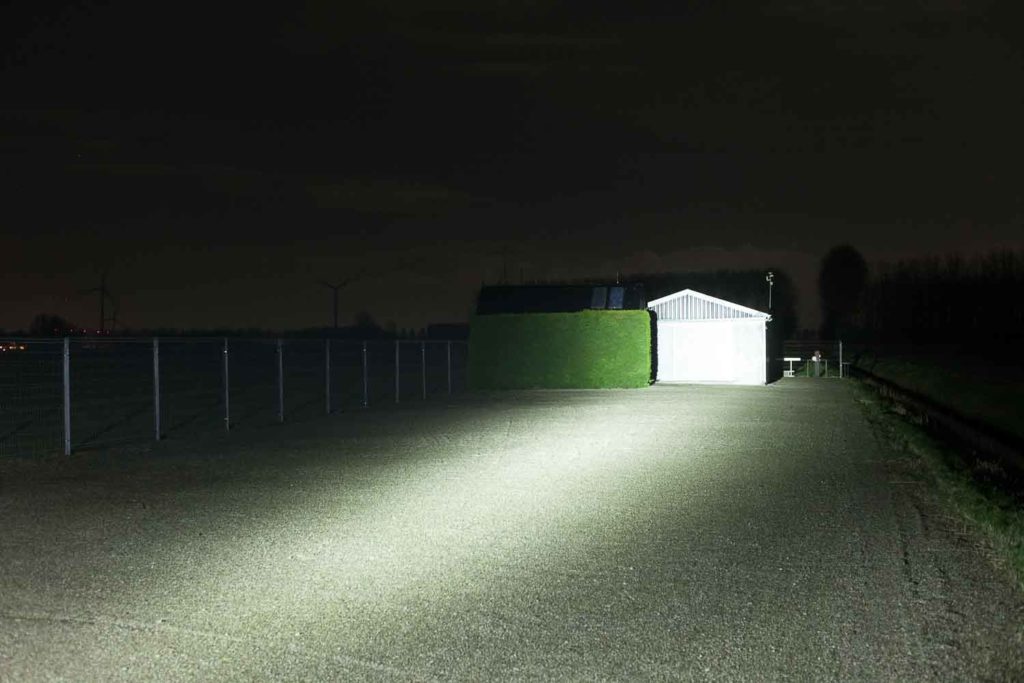
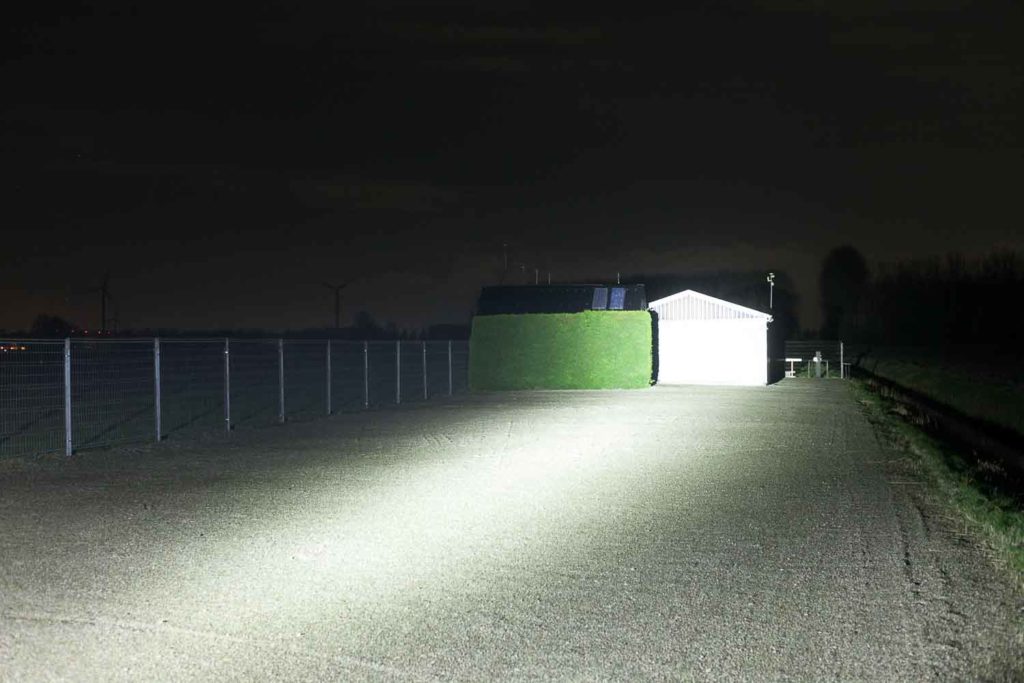
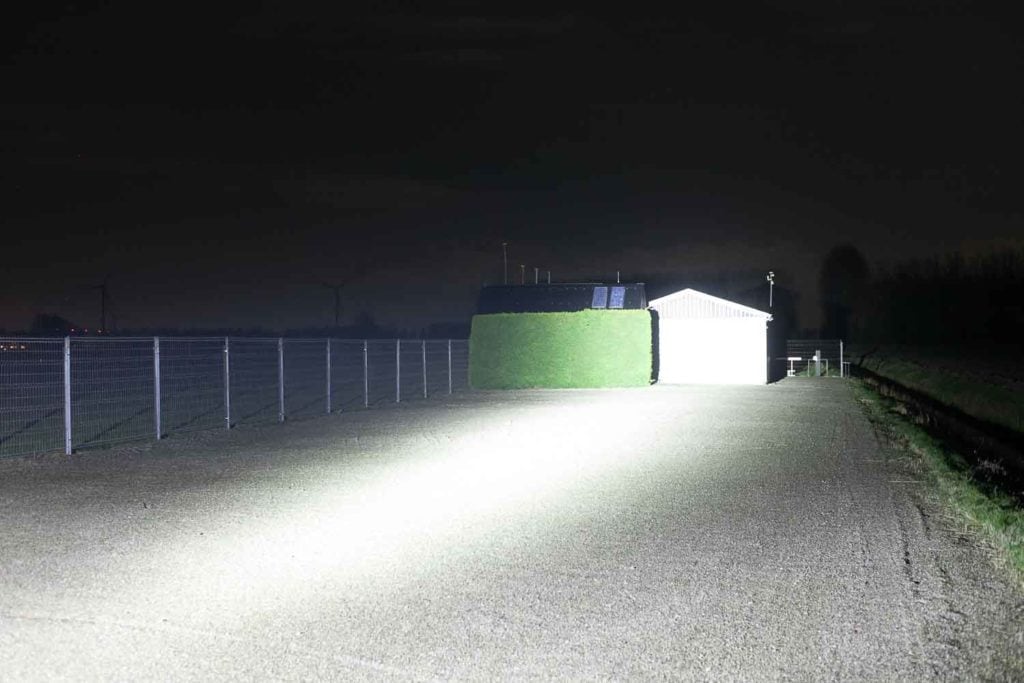
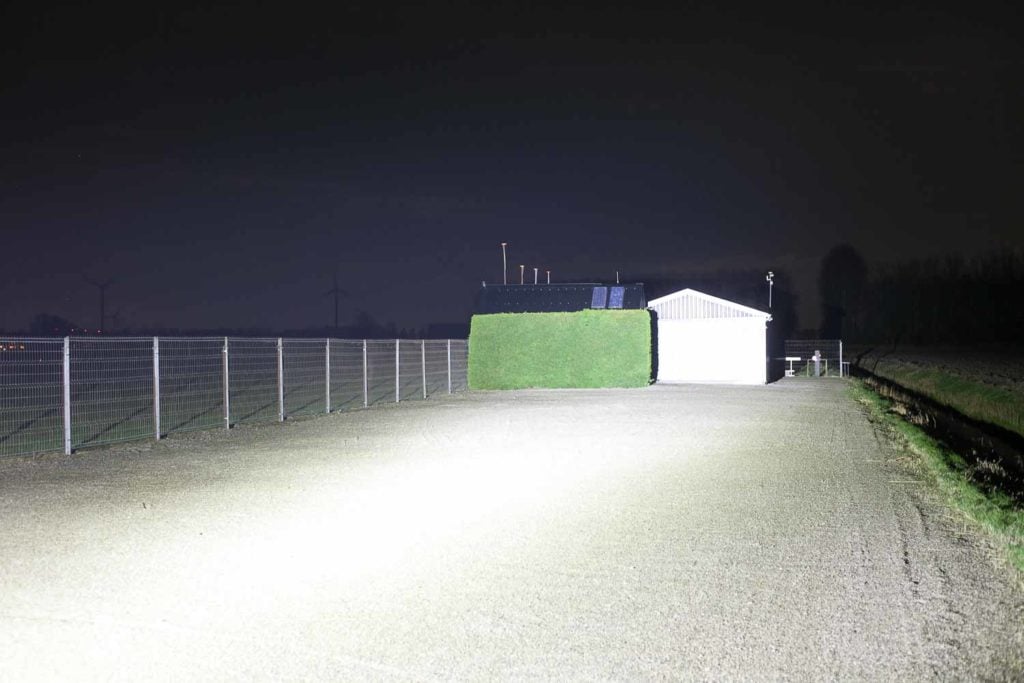
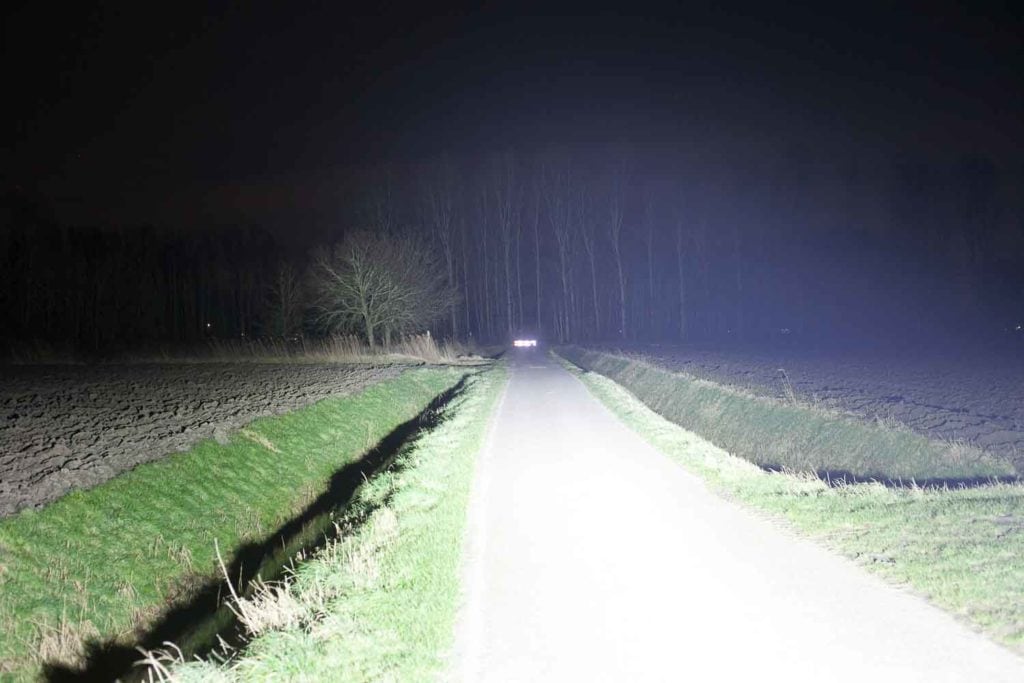
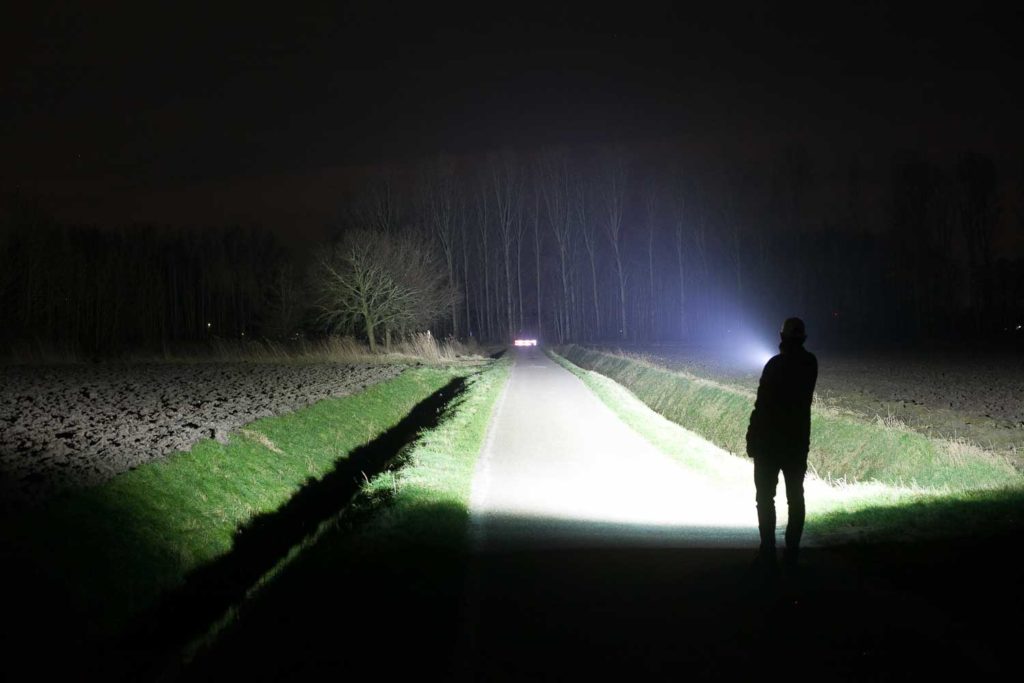


Final Verdict
Pros
- Anodization looks very nice
- Available in NW, CW or focus on throw with SFT40
- Plenty bright
- Built-in cooling fans (in handle) which can be turned on/off without the flashlight to be turned on
Cons
- Little strange behavior in Turbo and High mode with the increased brightness after the main drop in output
Explanation on star ratings:
1: Avoid: my phone flashlight would be a better choice – 2: Poor: significant defect or issues; almost unusable – 3: Average: some defects or issues; but still usable 4: Good: recommended (minor issues) – 5: Great: highly recommended

4.5 stars: ★★★★⋆
The MK38 is a very powerful flashlight that reaches 16,000 lumens with the SFT40 LEDs at turn on. Unfortunately, it doesn’t sustain a high output throughout the runtime, and the graphs look a bit weird in the 2 highest modes.
But it throws really well, especially considering the raw output.. it’s just insane!
Manker MK38 for sale
1lumen selects and reviews products personally. We may earn affiliate commissions through our links, which help support our testing.